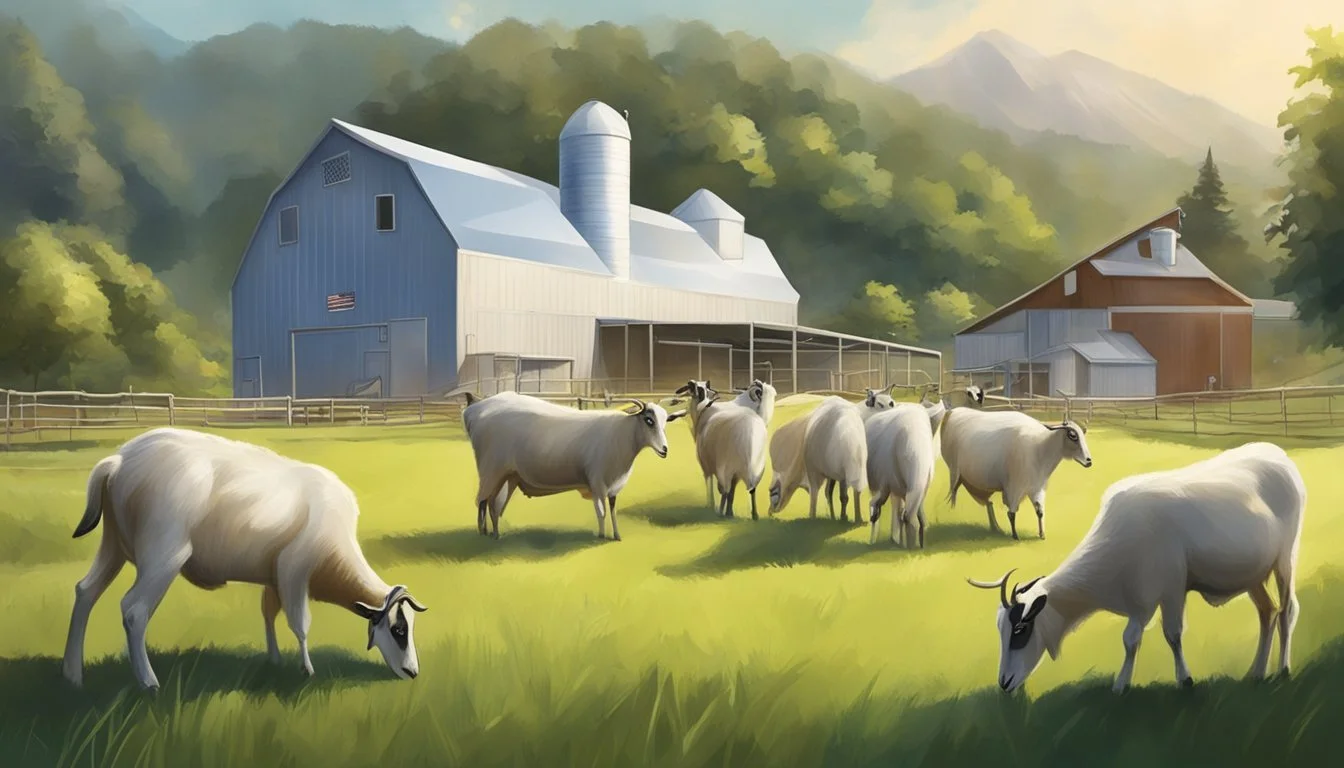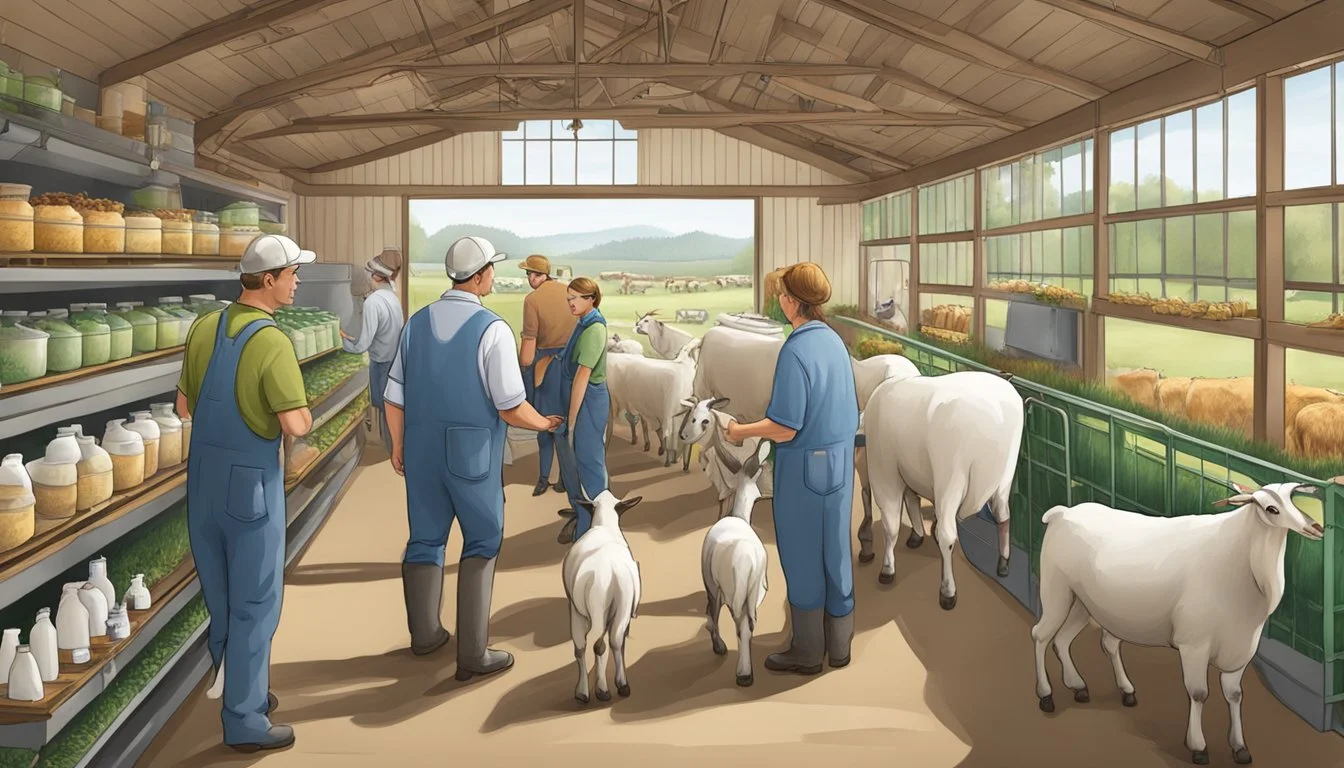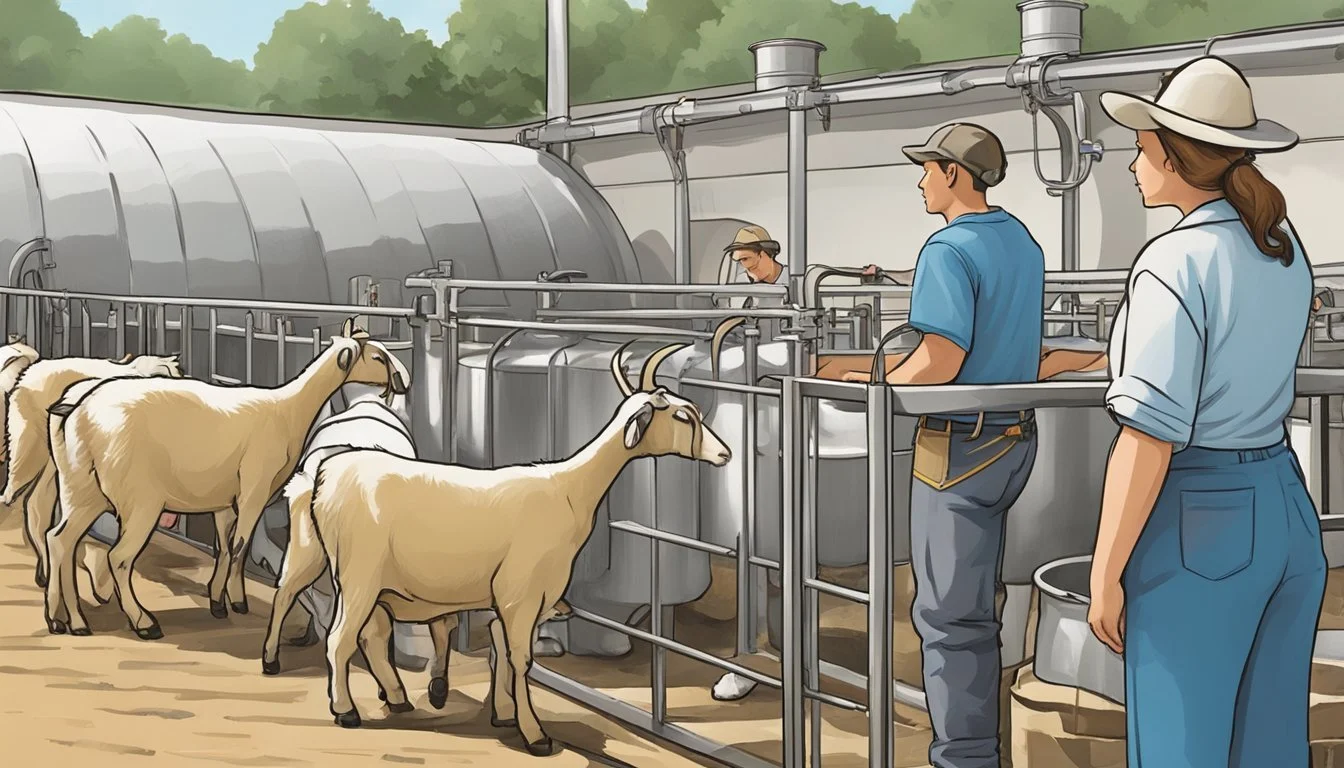How to Organize a Farm Tour
Highlighting Your Milking Goat Operations Efficiently
Organizing a farm tour can be an excellent way to showcase the inner workings of your milking goat operations to curious visitors, potential customers, and fellow farmers. It offers a unique opportunity for people to witness the care that goes into animal husbandry and the intricate process of sustainable dairy production. When planning a tour, it's important to consider what you hope to achieve — whether it’s to educate the public about farming practices, build local community connections, or broaden the market for your products.
A successful farm tour requires strategic planning and attention to detail. It's crucial to identify the key areas of interest that will engage your visitors, such as demonstrating the milking process or introducing the different breeds of goats on the farm. Safety protocols should be a top priority, ensuring that guests can navigate the farm without disturbing the animals or compromising the farm's operations. Additionally, storytelling serves as a powerful tool during such tours, allowing visitors to connect with the farm's history, the goats’ individual personalities, and the farm-to-table journey of the goat’s milk and related products.
Planning Your Farm Tour
A successful farm tour requires careful planning and a clear understanding of the visitors' expectations. Specifics related to audience interests, scheduling constraints, and biosecurity measures should shape the tour's design to ensure a safe and informative experience.
Understanding Your Audience
When planning a farm tour, it's critical to consider who the visitors are and what they aim to learn from the experience. If the target audience is families, the tour should include engaging, educational content suitable for all ages. For a specialized audience such as dairy professionals or agritourism students, the focus may shift to the technical aspects of milking goat operations.
Designing the Tour Schedule
The tour schedule should provide a comprehensive yet concise overview of daily operations. Structuring the itinerary to include demonstrations of milking processes and opportunities to interact with the goats can capture visitor interest. For private tours, flexibility in the schedule may allow for a more personalized experience, giving visitors in-depth insight at their own pace.
Morning Tours:
9:00 AM: Welcome and Introduction
9:15 AM: Breed Overview and Milking Demonstrations
10:00 AM: Cheese Making Process (if applicable)
Afternoon Tours:
1:00 PM: Welcome and Introduction
1:15 PM: Feeding and Husbandry Practices
2:00 PM: Sustainable Farming Discussion
Prioritizing Biosecurity
Biosecurity is paramount in any livestock operation. Visitors should be briefed on hygiene protocols, such as hand washing and disinfecting footwear, to prevent contamination. Clear signage and barriers can both direct foot traffic and protect sensitive areas of the goat operation. Tours should be designed to minimize disruption to the animals and risks to their health.
By focusing on these elements, one can organize an informative and memorable farm tour that highlights the intricacies of milking goat operations while considering the well-being of both the guests and the goats.
Milking Goat Operations Overview
In showcasing milking goat operations, it's essential to consider the specific breeds being milked, the established milking procedures and routines, and the comprehensive health and nutrition management systems in place.
Breeds and Characteristics
Dairy goat breeds each have distinct characteristics that affect milk production and farm management. For instance, the Nubian breed is known for high-butterfat milk, while the Saanen provides higher milk yields but with lower fat content. The choice of breed impacts not only the milking operation’s outputs but also its management practices, since each breed has different needs in terms of housing, temperament, and care.
Milking Procedures and Routines
A structured milking procedure ensures consistency, efficiency, and the health of the goats. Typically, dairy goats are milked twice daily using a routine that includes steps such as sanitation, machine milking or hand milking, and post-milking teat dipping. Innovations in milking parlors have increased the ease and efficiency of milking dairy goats, from basic stanchions to advanced pipeline systems.
Daily Routines include:
Pre-milking: Sanitation of equipment and udder cleaning
Milking: Attachment of the milking machine or manual extraction
Post-milking: Teat disinfection and health inspection
Health and Nutrition Management
The health and nutrition management of dairy goats is intricate and vital for optimal milk production. Quality feed, proper housing, and routine health checks are crucial. Producers offer balanced diets formulated to meet the unique nutritional requirements of milking goats, which typically include hay, grains, and necessary minerals and vitamins. The regular assessment of goats’ health includes monitoring for signs of distress or illness and providing preventive and therapeutic care as needed. This careful attention to health and nutrition not only boosts milk yield and quality but also extends the productive lifespan of the dairy goats.
Showcasing Milking Facilities
In organizing a farm tour, the milking facilities are the cornerstone of operations, essential for demonstrating the efficiency and hygiene of your milking goats operation. Prospective clients and visitors expect to see a well-maintained milking parlor, robust milk storage solutions, and the latest in milking automation technologies.
The Milking Parlor Experience
In the milking parlor, visitors should witness a seamless flow from goat entrance to exit. The parlor’s design is critical—a well-thought-out floor plan ensures goats are calm and handlers can operate efficiently. Visitors can learn about the milking process, observing how goats are ushered in, positioned, and then milked in a stress-free environment. They'll see firsthand how operators ensure cleanliness and monitor goat health during each milking session.
Milk Storage Solutions
Milk storage is the next pivotal step. Tours should highlight the transition from milking machines to chilling and storage. Here, visitors can understand how milk is rapidly cooled to maintain quality and showcase the tanks where milk is stored prior to transportation. Emphasis on sanitary conditions and temperature control underlines the commitment to quality and safety.
Milking Automation Technologies
Finally, integrating milking automation technologies demonstrates the farm's modern edge. Automation can range from simple pulsators to advanced robotic milking systems, offering an intriguing look at how technology improves not just efficiency but also animal welfare. Explaining how sensors assess milk quality and track goat health offers insight into the sophisticated nature of contemporary dairy operations.
Goat Health and Milk Quality
In the realm of milking goat operations, the health of the goats and the quality of the milk produced are paramount. Attention to disease prevention, adherence to rigorous milk safety standards, and a focus on nutrition all contribute to the high-quality dairy products that distinguish responsible farming practices.
Disease Prevention and Control
Maintaining a healthy goat herd is essential for the production of safe and high-quality milk. Farmers diligently monitor their herds for signs of illness, including mastitis, a common infection in dairy animals that can drastically affect milk quality. Key prevention strategies include:
Regular Health Check-ups: Veterinary visits for vaccinations and health assessments prevent the spread of infectious diseases.
Sanitary Living Conditions: Clean bedding and living environments minimize the risk of bacteria proliferation.
Quarantine Protocols: New or sick animals are isolated to prevent the spread of disease to the rest of the herd.
Milk Testing and Safety Standards
To ensure milk safety and quality, rigorous testing is conducted. The main focus areas are:
Bacterial Testing: Milk is tested for harmful bacteria to guarantee it's safe for consumption.
Pasteurization Process: Heat treatment kills pathogens without affecting nutrient content and flavor.
Equipment Sanitization: All milking equipment and storage containers are sterilized to prevent contamination.
Nutritional Contributions to Milk Quality
The diet of dairy goats directly affects the nutritional value and taste of their milk. High-quality feeds lead to milk that's not only delicious but also nutritionally rich. Farmers focus on:
Balanced Diets: Goats are provided with a balanced diet that includes adequate forage, grains, and clean water.
Colostrum Management: Newborn kids receive colostrum, the nutrient-packed first milk, critical for their immunity and development.
Supplementation: When necessary, dietary supplements are provided to address any nutritional gaps that could compromise milk quality.
Sustainable Farming Practices
When organizing a farm tour, showcasing sustainable farming practices is crucial. These methods not only support environmental health but also enhance the efficiency and productivity of milking goat operations.
Pasture Management
Proper pasture management is a cornerstone of a sustainable farm. Rotational grazing strategies can reduce soil erosion, improve pasture biodiversity, and encourage healthy grass growth, optimally nourishing the goats. Grazing plans should be structured so that forage plants have time to recover, supporting both animal health and pasture longevity.
Sustainable Crop and Garden Integration
Incorporating sustainable crops and gardens into the farm environment benefits both the soil and the animals. Intercropping and companion planting can enhance soil nutrients and deter pests, reducing the need for chemical inputs. For instance, planting legumes can naturally fix nitrogen in the soil, offering a dual benefit as a feed source and improving soil fertility.
Animal Husbandry and Biodiversity
A focus on animal husbandry underlines attention to animal welfare and genetic diversity within the herd. Diversifying livestock to include not just goats but perhaps also alpacas or horses can have synergistic effects on farm health through natural pest control and varied manure composition, contributing to a balanced ecosystem. Integrating biodiversity within animal herds and nearby wildlife is indicative of a robust and resilient agricultural system.
Product Diversification
Diversifying products is essential for milking goat operations to enhance market presence and increase revenue streams. By branching out from basic dairy offerings, farmers can appeal to a wider consumer base and add value to their business.
From Milk to Market
Milking goat operations can capitalize on a range of dairy products that are in demand. Cheese, with its variety of textures and flavors, stands out as a natural extension of raw milk processing. Particularly, goat cheese boasts a high butterfat content, making it a gourmet choice for consumers. Utilizing different cheese-making techniques can yield products such as soft chevre, aged gouda, or robust blue cheese, each opening up new segments in the market.
Beyond Milk - Diversified Goat Products
However, market opportunities extend beyond traditional dairy. Goat milk soap, for example, has gained popularity for its soothing properties and is sought after in the personal care industry. This niche product can be marketed based on its natural and hypoallergenic qualities. Additionally, bold ventures into products like goat milk-based lotions, or even textiles from goat hair, could further diversify a farm's offerings, tapping into markets that value sustainability and artisan craftsmanship.
Educational Activities and Engagement
When planning educational activities and engagement for a farm tour, it is crucial to design experiences that are both informative and interactive. Keeping visitors actively involved heightens their learning and enjoyment.
The Baby Goat Experience
Visitors are often enchanted by the chance to interact with baby goats. The Baby Goat Experience involves allowing guests to pet and feed the kids, which provides a hands-on opportunity to learn about the birthing and early care of goats. This activity can highlight the importance of early nutrition, socialization, and health checks for the young animals.
Interactive Milking Demonstrations
An Interactive Milking Demonstration not only showcases the milking process but also educates visitors on the importance of cleanliness, the skills required for milking, and the ways in which milk is used. Participants can try their hand at milking under supervision, offering a real feel of the homesteader's daily routine.
Farming as Education and Lifestyle
The section on Farming as Education and Lifestyle emphasizes homesteading as a sustainable way of life. Through presentations or informal talks, they can share insights about the benefits of farm-fresh produce and the self-sufficiency that comes with mastering dairy goat care and milking. It's a chance to inspire and educate individuals on sustainable living practices.
Each activity is crafted to engage visitors fully, allowing them not just to view but to participate in the daily operations of a milking goat farm.
Marketing and Promotion Strategies
Effective marketing and promotion are critical for attracting visitors to your milking goat operation. Thoughtful strategies can create buzz, showcase the uniqueness of your farm, and build strong community ties.
Creating Memorable Tour Experiences
One must design tours that go beyond the basics. For instance, a highlight could be allowing visitors to participate in milking goats, coupled with educational components that explain the process and benefits of goat milk. By focusing on aspects such as the production of goat cheese or yogurt, visitors can see the direct farm-to-table journey, enhancing the destination marketing strategies for the farm market.
Leveraging Social Media and Online Presence
A robust online presence utilizing platforms like Instagram, Facebook, and Twitter is essential. For a farm-to-table business, harnessing the power of social media marketing means showcasing the farm's daily operations and producing engaging content that tells the story of the goats and the products that come from their milk. Regular posts with high-quality visuals, live videos of farm activities, and informative captions can cultivate a following that feels connected to the farm’s brand and values.
Building Partnerships with Local Businesses
Forming partnerships with local restaurants, cafes, and shops can be a game-changer. By offering exclusive tours for partner businesses or collaborating on events, a farm can amplify its reach. Establishing agreements for local businesses to market the farm as a source for fresh, high-quality goat milk and related products reinforces the farm's position in the community as a trusted and integral entity.
Tour Logistics and Visitor Management
Organizing a farm tour requires meticulous planning to ensure that visitors receive an informative and enjoyable experience. Coordination of schedules, consideration of weather conditions, and ensuring safety and accessibility are critical for a successful milking goat operation tour.
Navigating Weather and Seasonal Considerations
Weather plays a significant role in the farm tour experience. Tours should be scheduled during seasons with favorable weather conditions to promote comfort and safety for visitors. For example, avoiding the rainy season can help prevent disruptions. It is advisable to have a backup plan in case of unforeseen weather changes, such as indoor viewing areas for milking demonstrations.
Handling Groups and Individual Visitors
Managing the schedule for both groups and individual visitors requires clear communication and efficient time allocation. When booking tours, group size should determine the frequency and duration of the tours to prevent overcrowding. For individual visitors or smaller groups, one can consider set times for joining existing tours or a self-guided tour option with clear signage.
Tour Safety and Accessibility
Tour safety is paramount. Paths should be kept clear, and slip hazards marked or eliminated. Devising a route that is easily accessible for all visitors, including those with mobility impairments, ensures inclusiveness. Moreover, ensuring that visitors wear appropriate clothing and footwear, and providing safety briefings at the start of the tour can minimize health and safety risks.
Feedback and Continuous Improvement
Gathering feedback is essential for the continuous improvement of your milking goat farm tour. It allows tour organizers to identify strengths and address any areas that may require enhancement, ensuring that the experience remains educational, engaging, and enjoyable for visitors.
Gathering Visitor Feedback
Collecting feedback can be accomplished through various methods. One effective way is to provide visitors with a simple, concise survey at the end of their tour. Questions should focus on the informative aspects of the tour, interactions with the goats, and the overall experience. This can include:
Tour content clarity: Was the information provided easy to understand?
Hands-on interaction: How enjoyable was the engagement with the milking goats?
Facilities: Were the viewing areas and amenities satisfactory?
Another approach is to opt for an informal conversation with visitors post-tour, where they can share their thoughts spontaneously. For those more comfortable with technology, digital feedback forms sent via email or accessible through QR codes can capture insights effectively.
Analyzing Tour Success and Areas for Growth
To analyze the tour's success and pinpoint areas for growth, organizers should aggregate and review feedback regularly. Key performance indicators might include:
Visitor satisfaction scores: High scores indicate success, while lower scores highlight areas needing attention.
Educational impact: Assess whether tourists feel more knowledgeable about goat milking operations post-visit.
Repeat visitation: An increase in repeat visitations suggests a positive experience.
Visitors' comments provide direct insights into what is working well and what could be improved. Organizers should categorize feedback into themes such as education, engagement, and facility quality to systematically address each area. For instance, if several visitors mention that they wish to interact more directly with the goats, the tour itinerary could be adjusted to include a supervised milking demonstration.
Implementing changes based on visitor feedback is crucial for the ongoing enhancement of the farm tour. Regularly updating the tour structure and content based on this analysis helps ensure that the experience remains fresh, informative, and enjoyable for all attendees.
Conclusion
Organizing a successful farm tour requires attention to detail, a clear understanding of the objectives, and effective communication. When showcasing milking goat operations, educational value and visitor engagement play pivotal roles.
Visitors should leave with:
A deeper appreciation of the milking process
Knowledge of goat care and management
Understanding the importance of sustainability in farming
To ensure a memorable experience, one must provide:
Interactive Demonstrations
Milking sessions
Feeding times
Hoof trimming demonstrations
Thoughtful Amenities
Comfortable viewing areas
Informational handouts
Sample dairy products
Takeaways
Brochures with farm details
Contact information for future inquiries
Souvenirs to remember the visit
Feedback should be encouraged, as it is essential for continuous improvement. A simple, yet effective mechanism, such as a suggestion box or an online form, can be used to collect visitors' opinions.
The ultimate goal is to establish a lasting relationship with the community, emphasizing transparency and the dedication to animal welfare and quality products. A well-organized farm tour not only educates the public but also builds trust and fosters a positive image for the farm.






